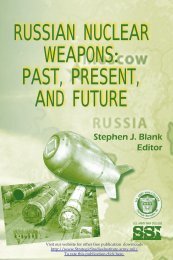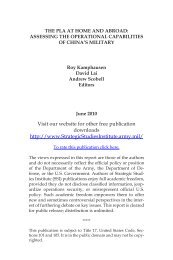The United States and China in Power Transition - Strategic Studies ...
The United States and China in Power Transition - Strategic Studies ...
The United States and China in Power Transition - Strategic Studies ...
Create successful ePaper yourself
Turn your PDF publications into a flip-book with our unique Google optimized e-Paper software.
With an adjustment <strong>in</strong> its national strategy, <strong>Ch<strong>in</strong>a</strong><br />
followed a two-pronged approach to improve its<br />
military power. On the one h<strong>and</strong>, <strong>Ch<strong>in</strong>a</strong> purchased<br />
advanced battleships <strong>and</strong> fighter jets from Russia as<br />
quick fixes for deal<strong>in</strong>g with the Taiwan issue. On the<br />
other h<strong>and</strong>, <strong>Ch<strong>in</strong>a</strong> made an all-out effort to embrace<br />
the RMA <strong>and</strong> transform its military mach<strong>in</strong>e.<br />
To <strong>Ch<strong>in</strong>a</strong>’s fortune, its grow<strong>in</strong>g economy provided<br />
timely resources for these huge undertak<strong>in</strong>gs. Indeed,<br />
as Ross <strong>and</strong> Monroe put it, <strong>Ch<strong>in</strong>a</strong>’s powerful economy<br />
was fuel<strong>in</strong>g a credible military force. (See the quotes<br />
from Ross <strong>and</strong> Monroe <strong>in</strong> the earlier section.) From<br />
the mid-1990s to the present, <strong>Ch<strong>in</strong>a</strong> has topped the<br />
world <strong>in</strong> spend<strong>in</strong>g the most amount to purchase advanced<br />
conventional weapon systems abroad (mostly<br />
from Russia, see the Stockholm International Peace<br />
Research Institute Yearbooks of Armaments, Disarmament,<br />
<strong>and</strong> International Security for the records).<br />
At the same time, <strong>Ch<strong>in</strong>a</strong> also evidently <strong>in</strong>creased its<br />
military spend<strong>in</strong>g to cover the other expenses of its<br />
military transformation. However, this extraord<strong>in</strong>ary<br />
<strong>in</strong>crease <strong>in</strong> defense spend<strong>in</strong>g did not seem to bother<br />
the Ch<strong>in</strong>ese leaders—they, after all, had plenty <strong>in</strong><br />
their treasury. Indeed, as <strong>Ch<strong>in</strong>a</strong>’s economy expected<br />
to have decades to grow before reach<strong>in</strong>g its full capacity,<br />
<strong>Ch<strong>in</strong>a</strong> can bear this burden; <strong>and</strong> <strong>Ch<strong>in</strong>a</strong>’s military<br />
modernization will have bountiful fund<strong>in</strong>g for<br />
its development. In this sense, <strong>Ch<strong>in</strong>a</strong> is more like the<br />
<strong>United</strong> <strong>States</strong> when it was on its way to becom<strong>in</strong>g a<br />
great military power than the Soviet Union on its way<br />
to bankruptcy.<br />
<strong>The</strong> result of <strong>Ch<strong>in</strong>a</strong>’s efforts is clearly identifiable.<br />
<strong>The</strong> Pentagon has documented the developments <strong>in</strong><br />
the growth of Ch<strong>in</strong>ese military power through its annual<br />
report to the Congress s<strong>in</strong>ce 2000. <strong>The</strong> follow<strong>in</strong>g<br />
191

















